Table of contents

fact
accesories
landing gear & Spring elements
Technology: suspension / chassis
Technology: suspension / chassis
Suspension and chassis explained simply
Steering, braking, bouncing, damping, keeping in lane – with these complex tasks, the telescopic suspension fork (short: telescopic fork) is a real multifunctional talent. Reason enough that the good old telescopic fork overshadows almost all alternative front wheel guides.
Werner Koch
12/22/2010
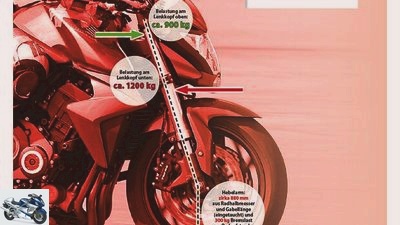
archive
Braking deceleration with 9.806 m / s2 – Due to the long lever arm between the wheel contact area and the clamp on the lower triple clamp there is a bending load of around 1200 kilograms. A commercially available upside-down fork can therefore bend backwards by up to 15 millimeters (measured on the wheel axle) when the brakes are fully loaded..
The revolution passed her by without a trace. Even in the early days of motorcycles, eager engineers designed all possible and impossible alternatives to the telescopic fork. From today’s point of view, no even the most refined front wheel control handled the multiple tasks as perfectly as the telescopic fork. A closer look at this construction reveals some obvious weaknesses, but the sum of its properties makes the pipe-in-pipe construction unbeatable. Especially since some theoretical disadvantages are reversed in practice. When braking with the telescopic fork, regardless of whether it is upside-down or conventional, the steering geometry changes dramatically in the direction of the spring travel “unstable” and thus towards “handy”.
Buy complete article
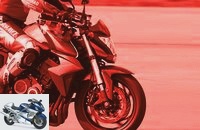
Technology: suspension / chassis
Suspension and chassis explained simply
4 pages) as PDF
€ 2.00
Buy now
Small example: By submerging the front and at the same time rebounding the rear, the caster of a touring sports motorcycle is reduced from 104 to 79 millimeters, while the steering head angle changes from 65 to 69 degrees and is therefore extremely steep. Because the telescopic fork moves not only upwards but also backwards due to the inclination (steering head angle), the wheelbase is also shortened from 1450 to 1405 millimeters. All in all, the touring sports motorcycle theoretically has a highly unstable geometry in this braking phase, but this has the advantage that the motorcycle can be tilted easily and quickly on the brakes. The necessary stability results from the high restoring force of the caster due to the braked front wheel.

archive
The 35-millimeter standpipes were not up to the Honda CBX 1000 and gave the six-cylinder chassis the bad reputation.
In the opposite case, i.e. when accelerating fully, the telescopic fork rebounds and the steering geometry becomes “more stable”. The geometric changes due to the compression and extension of the telescopic fork adapt almost perfectly to the respective driving situation. Swinging forks, pulled or pushed, the telescopic fork flattened them all. In their need, the designers made do with drastically increased standpipe diameters (up to 50 millimeters) before the whole system was turned upside down at the end of the 1980s. Upside-down, or USD for short, was the name of the thing that brought a few decisive advantages. On the one hand, the area on the lower triple tree, which is subject to extreme bending forces, was sustainably defused by the large diameter. On the other hand, during compression and the associated bending moment, the immersion tube is pushed into the standpipe, which in many USD constructions contributes to more stability due to the increased overlap.
This high level of stability is one of the reasons why the diameter of USD components has only changed for a few manufacturers over the past 20 years. Most large series machines currently only have 41, 43 millimeters or, in a few cases, 45 millimeter thick immersion tubes installed. What is good for the weight and at the same time reduces friction. The handicap of the undesirable high friction between the standpipe, immersion tube and sealing rings was often the reason to replace the telescopic fork with low-friction front wheel designs. BMW first made a name for itself with Telelever, with the newer K four-cylinder engines with the Duolever system. There the wheel carriers are supported on the frame by massive trailing arms with roller bearings. An intermediate shock absorber takes over the suspension and damping. Was that the end of the telescopic fork? Not at all, because there is no Duolever construction on the new Munich super sports bike S 1000 RR, but a conventional USD fork from Sachs.
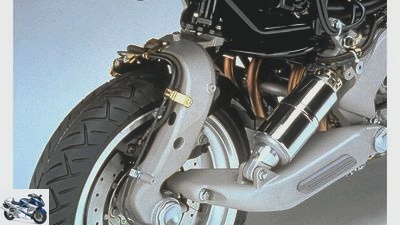
archive
Heavy, complex and with a relatively small steering angle, the experimental Yamaha GTS 1000 disappeared from the market after a few years.
Attempts to replace the telescopic fork were stifled in the beginning, even though the alternative BMW front suspensions are the only systems in the world that have been able to establish themselves on the market. As a reminder: Yamaha tried in 1993 with a stub axle steering on the sports tourer GTS 1000 (see photo above), and Bimota wanted to revolutionize the supersports scene with the hub steering in the Tesi 1D. Both systems could not put the proof of their theoretical advantages into practice and disappeared from the market. The big disadvantages: expensive and time-consuming, too little steering angle for everyday motorcycles, indifferent steering force transmission.
Because the countless prototypes in racing with their alternative wheel guides have clearly demonstrated one thing: For a racing or super sports motorcycle there was and still is no better solution than the compact and inexpensive telescopic fork.
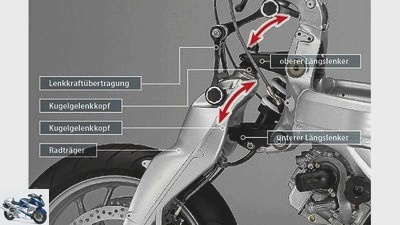
archive
In contrast to the telescopic fork, the elevation curve on the front wheel (green arrow) is slightly arched. The trailing arms mounted in the frame rotate in low-friction roller bearings, while the “steering head bearings” move in ball joints with sliding bearings during steering and spring movements (red arrows).
Some of the advantages of the BMW Duolever (see Duolever), such as the braking compensation or the high torsional stiffness, turn into the opposite in some extremely dynamic driving situations. In plain language: If the motorcycle does not bend in hard Bremen, the driver will not have any feedback for the limit area. A fact that is only important without ABS.
Often too much of a good thing: stability and rigidity If you take a close look at the torsional stiffness of modern wheel guides in practice, it becomes clear that a certain flexibility can definitely be an advantage. In this way, interference from the road surface, i.e. transverse grooves, parting lines or bumps in rapid succession, are absorbed in a flexible system, while extremely rigid structures can initiate these impacts into the chassis and trigger knocking of the handlebars or chattering, i.e. high-frequency vibrations on the front wheel.
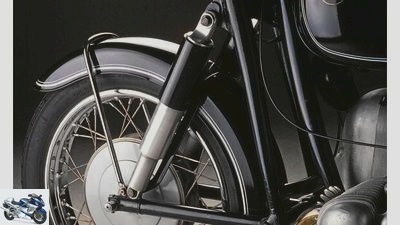
archive
The pushed long swing fork, in the picture the BMW R 69 S, was considered the optimum in comfort and stability for a long time until the end of the 1960s.
In addition, the so-called wheel elevation curve, i.e. the course of the wheel during compression due to bumps, is almost perfect with the telescopic fork. All other systems, with the exception of the drawn long-swing fork, partially spring against the direction of impact, which the driver perceives as an uncomfortable, sometimes trampling driving experience.
A fine example of the specifically designed flexibility of a telescopic fork are the triple clamps of the world champion machines Yamaha M1 and the Aprilia Superbike by Max Biaggi. With both, at first glance, bizarre milled upper triple clamps hold the stanchions and, thanks to the deep recesses and perforated surfaces, allow a more or less large twist in an inclined position or when braking.
The extremely massive and often clamped lower triple clamps (photo above) have all disappeared in racing and in series production. Only a few tuners still rely on such martial components for formal considerations.
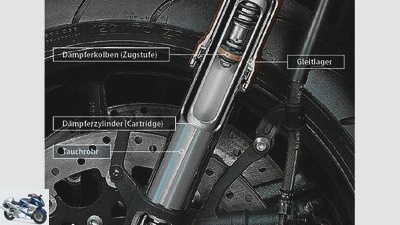
archive
This system has established itself in all displacement classes, and it is easy to see: the bearing shells, which either sit firmly in the standpipe or float on the upper end of the immersion tube, increase the overlap when immersed.
Over the years, the design-related disadvantages of the telescopic fork have been systematically eliminated. With low-friction surface coatings of the standpipes with chrome nitrite (shiny gold) or carbon (dark gray to black), the friction of the slide bearing points was reduced (photo above).
It will be interesting to see what the engineers and designers will come up with over the next few years to offer an alternative to the telescopic suspension fork that not only shines with theoretical advantages.
Triple clamps
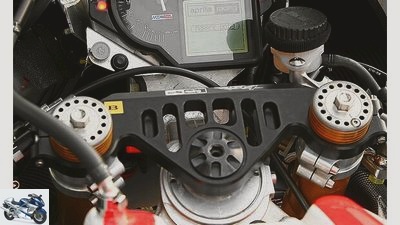
archive
Elaborately designed triple clamps turned out to be a technical mistake.
In order to give the front end the desired flexibility, specially calculated and delicately milled upper triple clamps are used in racing. Feedback and the limit area should become more transparent. In the 1990s, attempts were made to make USD forks even more rigid with dip tubes up to 50 millimeters thick and hand-wide, multiple clamped lower triple clamps. A mistake.
Related articles
-
BMW K model, new, for 2005: technology
MOTORCYCLE counselor technology & future BMW K model, new, for 2005: technology BMW K model, new, for 2005: technology The revealing Michael Pfeiffer…
-
2snap counselor technology & future Technology report Technology report Traction control Content of Traction control ?? Everyday in the car, hardly…
-
Technology PS driving dynamics cornering ABS
markus-jahn.com 18th pictures markus-jahn.com 1/18 … as well as in the city to its limits. markus-jahn.com 2/18 On the one hand, this smooth transition…
-
Technology: suspension and chassis
fact accesories landing gear & Spring elements Technology: suspension and chassis Technology: suspension and chassis New trend: Big Piston Fork New trend…
-
Technology: aerodynamics and acoustics comparison
fact counselor technology & future Technology: aerodynamics and acoustics comparison Technology: aerodynamics and acoustics comparison Close to the wind…
-
PS reader question about motorcycle technology
jkuenstle.de counselor technology & future PS reader question about motorcycle technology PS reader question about motorcycle technology Beam or banana…
-
Technology of the new 600 super sports car
counselor technology & future Technology of the new 600 super sports car Technology of the new 600 super sports car New base The new 600 super athletes…
-
The technology of the chassis and suspension
Bilski counselor technology & future The technology of the chassis and suspension Technology: rear wheel The technology of the chassis and suspension…
-
ZF equips Betamotor off-road bikes with chassis technology
beta accesories landing gear & Spring elements ZF equips Betamotor off-road bikes with chassis technology ZF equips off-road bikes Beta engine: perfectly…
-
Technology: Seamless transmission from the Honda RC 213 V.
2snap Sports & scene Motorsport Technology: Seamless transmission from the Honda RC 213 V. MOTOGP technology seamless gear of the Honda RC 213 V Full…